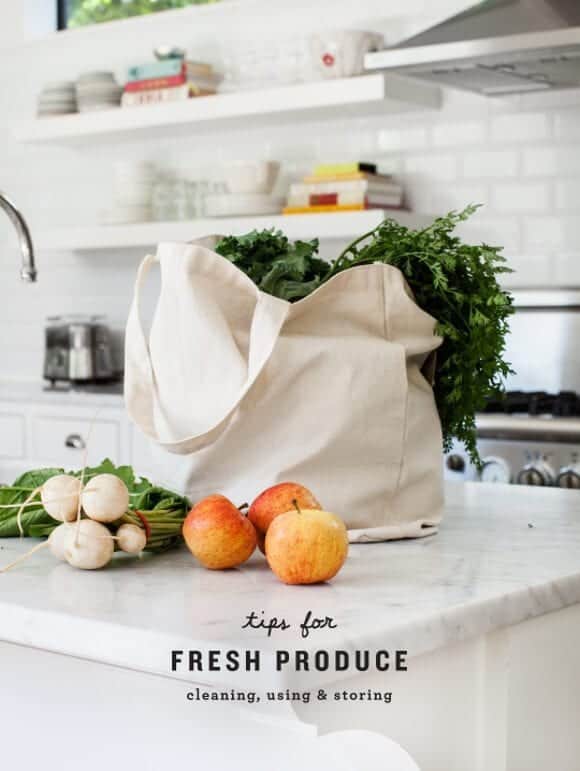Once or twice a week, I get a huge bounty of fresh produce. My Farmhouse box arrives every other Wednesday, and I shop my local farmers market on Saturdays. Over the years I’ve learned a few strategies for cleaning, storing and using fruits and vegetables to make sure everything lasts throughout the week. I absolutely hate throwing food away. I know you do too, so I’m hoping you find this little guide helpful to avoid food-waste for yourself. We’ve partnered with McCormick to share these tips as well as a few easy ideas to whip up farm-fresh dishes using their Gourmet dried herbs & spices.
CLEANING TIPS: 1. Wash fresh fruits and vegetables (except mushrooms) in cold running water. Clean mushrooms with a damp cloth to gently remove the dirt. 2. I like to wash leafy greens in a large bowl so any dirt can fall to the bottom. 3. Dry salad leaves in a spinner or just lay them on a towel for 20 or so minutes. 4. Scrub root veggies (sweet potatoes, carrots, etc.) with a brush to remove dirt. Or just rinse & peel, but I like to preserve the nutrients by leaving skins on. 5. Except for leafy salad greens, fruits and vegetables should be washed just before you’re ready to use it, (i.e. not days in advance).
STORAGE TIPS: 1. Certain vegetables (and fruits) contain a gas called ethylene. Ethylene triggers the ripening process and will deteriorate some veggies faster. My #1 storage tip is to make sure you store ethylene-producing vegetables separate from ethylene-sensitive vegetables. ethylene-producing produce: apricots, avocados, bananas, cantaloupe, melons, mango, peaches, pears, tomatoes. ethylene-sensitive produce: apples, asparagus, broccoli, carrots, cucumbers, eggplants, green beans, leafy greens, potatoes, summer squash. 2. Store veggies un-cut to last the longest. Cut produce should be tightly covered and used within 1-2 days. 3. Below are a few storage suggestions. This is just a rule of thumb – your vegetables may last longer or shorter depending on when (and where) they were picked and when you took them home.
USING FRESH PRODUCE: At the start of the week (with the freshest fruits & veggies): I always use up my most fragile produce first. Early in the week I make salads from crisp lettuces, cucumbers, peppers, and lightly roasted summer or winter squash. I start the week off with lightly cooked meals while produce is at peak freshness. For example: Salads with chili-lime dressing: whisk olive oil, lime, honey, and chili powder. Sliced veggie plates with hummus: blend chickpeas with olive oil, lemon, garlic, salt, pepper, cumin & coriander. Simple pasta: lightly sauté summer squash with basil, oregano & parmesan.
Toward the end of the week (with any veggies that are left): I usually end up with a random assortment of (lightly wilted) veggies to use up. I often make frittatas or stir fries but, especially now that it’s fall, my favorite go-to meal is soup. Chop everything up and toss it in a big soup pot with olive oil, salt & pepper. Cook veggies until lightly browned, add a splash of white wine (or white wine vinegar) and let it cook out (2-3 minutes). Add vegetable broth and simmer until all veggies are cooked through. Create different flavor profiles by changing just a few spices and pantry items: Mediterranean: add crushed red pepper, bay leaves, oregano & a can of tomatoes. (Click for the full recipe). Mexican/southwestern: add coriander, chili powder, cumin & black beans for a soup that’s similar to this vegetarian chili. Indian: add madras curry, turmeric, cayenne & a can of coconut milk for a creamy curried soup similar to this one.
This post is sponsored by McCormick. All thoughts, words and images are my own. Thank you for supporting the sponsors that support Love and Lemons.
